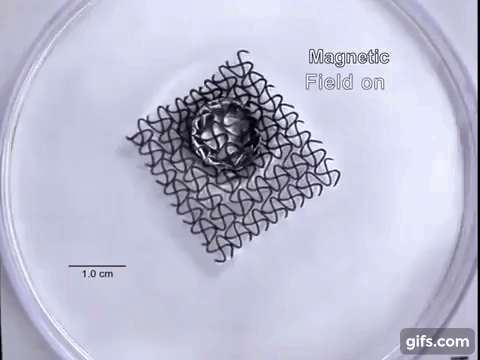Early-stage experiments at North Carolina State University (NCSU) have yielded a new class of 3D printed smart material. Magnetically-reactive and mesh-like by design, this material could lead to future floating robots capable of drug delivery, or active scaffolds suitable for tissue engineering.
At present, the 3D printed smart material is shown mimicking the movement of a water strider insect (also known as pond skaters, water skeeters and, apparently, Jesus bugs – for an obvious reason). It grabs small objects, and carries (then drops) a bead of water in an act that appears more like a magic trick.
Professor Orlin Velev, S. Frank and Doris Culberson Distinguished Professor at NCSU and corresponding author on a paper detailing this new material comments, “This research shows capabilities in the emerging field of combining 3D printing and soft robotics.”

3D printed with complete flexibility
The new 3D printable smart material from NCSU is a flexible, elastomer-based polymer. For activation, the polymer has been impregnated with iron particles that respond to a magnetic field. When combined, these two ingredients make a paste, which was 3D printed by the team using a custom built syringe barrel and CNC mini-mill setup.
The exact way that the iron particles in the material respond to a magnetic field is determined by the 3D design of the material. Professor Velev explains, “With 3D printing, we can control the shape before and after the application of the magnetic field,”
“The structures are also auxetic, which means that they can expand and contract in all directions.”
Future soft robotics
Experimenting with the auxetic meshes, the Velev Research Group created three different demonstrative structures: a simple magnetic mesh, an extending grabber, and a water dispenser. In each of these designs the mesh takes on a slightly different shape, for example, the spaces in the mesh appear much tighter in the dispenser than those in the simple mesh.
For movement, all objects are places in a petri dish filled with water. Beneath the dish, there is an electromagnet. By turning the electromagnet on and off, the researchers stimulate a pre-programmed response in the floating mesh above. The extending grabber, for example, is used to capture a small ball of foil.
“For now,” Professor Velev says, “this is an early stage proof-of-concept for a soft robotic actuator,” already though the team is looking toward the next steps for this smart material. As detailed in the published studies conclusions, “Future research in such structures may entail the making of intelligent, multiresponsive, 2D and 3D magentoactive materials and devices,”
Further, “This new class of magnetoactive actuators enabled by this 3D printing technique enables fabrication of a with potential applications, spanning active tissue scaffolds for cell cultures and various types of soft robots mimicking creatures that live on the surface of water.”
“3D‐Printed Silicone Soft Architectures with Programmed Magneto‐Capillary Reconfiguration” is published online in Advanced Materials Technologies. The paper is co-authored by Sangchul Roh, Lilian B. Okello, Nuran Golbasi, Jameson P. Hankwitz, Jessica A.‐C. Liu, Joseph B. Tracy and Orlin D. Velev.
Is this your Research Team of the Year? Nominate the Velev Group and more for the 2019 3D Printing Industry Awards.
For more 3D printing research updates subscribe to the 3D Printing Industry newsletter, like us on Facebook and follow us on Twitter. Consider 3D Printing Jobs for your next research opportunity.
Featured image shows a 3D printed ultrasoft magnetic mesh. Clip via Sangchul Roh



